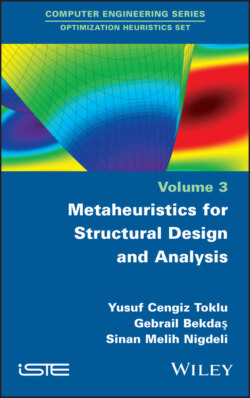Metaheuristics for Structural Design and Analysis

Реклама. ООО «ЛитРес», ИНН: 7719571260.
Оглавление
Yusuf Cengiz Toklu. Metaheuristics for Structural Design and Analysis
Table of Contents
List of Illustrations
List of Tables
Guide
Pages
Metaheuristics for Structural Design and Analysis
Preface
Introduction. I.1. Generalities
I.2. Structure of the book
1. Evolution of Structural Analysis and Design
1.1. History of design
1.2. From empirical rules and intuition to FEM
1.3. From FEM to AI
2. Metaheuristic Algorithms
2.1. A brief history of the development of metaheuristic algorithms
2.2. Generalities about metaheuristic algorithms
2.3. Evolutionary algorithms
2.3.1. Genetic algorithms
2.3.2. The differential evolution algorithm
2.4. Swarm intelligence
2.4.1. Particle swarm optimization
2.4.2. The flower pollination algorithm
2.4.3. The bat algorithm
2.5. Other metaheuristic algorithms. 2.5.1. Simulated annealing
2.5.2. Teaching–learning-based optimization
2.5.3. Harmony search
2.5.4. The Jaya algorithm
3. Application of Metaheuristic Algorithms to Structural Problems
3.1. Objective function
3.1.1. Weight
3.1.2. Cost
3.1.3. Response
3.1.4. Effectiveness
3.1.5. CO2emissions in construction
3.2. The design constraints
3.2.1. Stress
3.2.2. Deformations
3.2.3. Buckling
3.2.4. Fatigue
3.2.5. Design regulation rules
4. Applications of Metaheuristic Algorithms in Structural Design
4.1. Generalities in structural design
4.2. Sensibility analyses and reliability
4.3. Types of structural optimization
4.4. Basic structural engineering applications. 4.4.1. Vertical deflection minimization problem of an I-beam
4.4.2. Cost optimization of the tubular column under compressive load
4.4.3. Weight optimization of cantilever beams
4.5. Appendix 11
4.6. Appendix 2
4.7. Appendix 3
5. Optimization of Truss-like Structures
5.1. The optimum design of truss structures
5.1.1. Analyses of truss structures
5.1.2. Review of the literature on the optimization of truss structures
5.2. Numerical applications in the optimization of truss structures
5.2.1. A 5-bar truss structure optimization problem
5.2.2. A 3-bar truss structure optimization problem
5.2.3. A 25-bar truss structure optimization problem
5.2.4. A 72-bar space truss optimization example
5.2.5. A 200-bar planar truss optimization example
5.3. Tensegrity structures
5.4. Appendix 11
5.5. Appendix 2
6. Optimization of Structures and Members
6.1. Optimum design of RC beams
6.2. Optimum design of RC spread footings
6.3. Optimum design of RC columns
6.4. Optimum design of RC frames
6.4.1. The first example: two-span two-story RC frame
6.4.2. The first example: two-span two-story RC frame
6.5. Optimum design of RC cylindrical walls
6.5.1. Optimum design of axially symmetric RC walls
6.5.2. Optimization of post-tensioning forces for cylindrical walls
6.5.3. Optimization of post-tensioned axially symmetric cylindrical RC walls
7. Optimization in Structural Control Problems
7.1. Optimum design of tuned mass dampers (TMD)
7.1.1. Time domain-based optimization of TMDs
7.1.2. Frequency domain-based optimization of TMDs
7.1.2.1. Optimum results for a 10-story structure
7.1.2.2. Optimum results for a 40-story structure
7.1.2.3. Optimum results for a 40-story structure
7.2. Optimum design of base isolation systems
8. Applications of Metaheuristic Algorithms to Structural Analysis
8.1. Fundamentals of the method
8.2. Applications to structures, generalities
8.3. Applications to trusses and truss-like structures
8.4. Applications to plates
8.5. Further studies on the analysis of structures with TPO/MA
Future Trends
References
Index. A, B, C
D, E, F
G, H, I
J, L, M
O, P, R
S, T
U, V, W
WILEY END USER LICENSE AGREEMENT
Отрывок из книги
To Güler Toklu
Optimization Heuristics Set
.....
Applications of metaheuristic algorithms on the design and analysis of structures are a relatively new subject with advances made every year and in every corner of the globe. In the concluding chapter, future expectations on this subject are discussed. It is stated that the tools used nowadays are basic tools of Artificial Intelligence (AI) and that with the amalgamation of design and analysis – along with other aspects of construction like management, planning, financing, controlling and site work – a huge problem lies ahead, requiring much more elaborate tools in order to be solved. When one considers that these operations will not only be carried out in familiar environments, but also perhaps in remote areas with harsh conditions, the difficulty of the task awaiting humanity can somehow be envisaged.
Matrices hold a particularly important place in the history of analyses of structures. Felippa (2001) addresses this aspect under three titles: creation, unification and FEMinization, the last term meaning the launching of “[...] the direct stiffness method [...] as an efficient and general computer implementation, as yet unnamed, finite element method (FEM)”. Addis (2003) states that the main causes of failure in historical structures were wind loads, foundation problems and fires. We must add earthquakes to these effects for some parts of the world. Addis mentions the importance of full-scale tests on small physical models in historical times.
.....